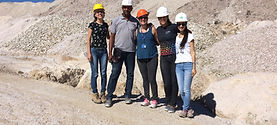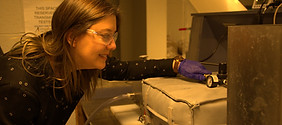Juliana Reinert
Geotechnical & GeoEnvironmental Engineer
Research Statement
Juliana Reinert focuses on applied interdisciplinary research that addresses current problems in geoenvironmental and geotechnical engineering. Juliana's research interests include, but are not limited to, use of geosynthetics, landfill design, proper disposal and reuse of mining waste, slope stability of soils and waste, and development of algorithms for geotechnical engineering applications. She has field and consulting experience in the same areas of her research interests, which reflects in the teaching she passes to her students.
Research Grants

spatial variability of soil properties using probabilistic approach
Amount funded:
R$ 46,800.00
Duration:
April 01, 2015 - February 28, 2018
Field of knowledge:
Civil Engineering - Geotechnical Engineering
Principal researcher:
Prof. Juliana Reinert
Home Institution:
Federal Center of Technological Education (CEFET-MG). Curvelo-MG-Brazil
Assoc. researchers:
Prof. Anderson Moreira de Vasconcelos, 4 undergraduate students
Abstract:
This Research was developed with the local community, EMATER-MG and IMA, aiming to study the variability of the soil in the region of Curvelo-MG-Brazil to help local small farmers to increase their productivity and supply food to the local schools.
The main goal of this research was to develop variability maps until 1 m deep, based on soil laboratory tests such as: pH analysis, colorimetry spectrometer, unit weight, grain size distribution, Atterberg limits, and natural water content. The soil samples were collected using a mechanical auger in spatially distant points mapped using a precision GPS. The maps were elaborated using the software MatLab.
Publications:
REINERT, J. et al (2021). 'Study of soil properties in the Curvelo-MG region based on laboratory tests for the elaboration of variability maps with a probabilistic approach', Brazilian Journal of Development, BrJournals, 7 (3): 30833-30844 (DOI 10.34117/bjdv7n3-690).
.jpg)
Use of quartz mining waste from Gouveia-MG-Brazil for reinforcement of subgrade and subbase used in paving layers
(Part of the research-industry partnership with Agrocity mining Ltd: Sustainable Reuse of Gouveia’s Quartz Mining Waste)
Amount funded:
R$ 16,000.00 for student's fellowship
Duration:
March 01, 2016 - February 28, 2017
Field of knowledge:
Geotechnical and Geoenvironmental Engineering
Principal researcher:
Prof. Juliana Reinert
Home Institution:
Federal Center of Technological Education (CEFET-MG). Curvelo-MG-Brazil
Assoc. researchers:
Prof. Lourdiane Gontijo das Mercês Gonzaga, 5 undergraduate students
Abstract:
This research presents a study on the resistance variation of silt soils of the Gouveia-MG region, mixed with 5, 10, 15 and 25% of fine residues, for use in paving layers (sub-grade reinforcement). The mining waste was analyzed using Scanning Electron Microscopy with X-Ray Fluorescence Spectrometry, X-ray Diffraction and particle size distribution. For the analysis of the resistance of the incorporation of the fine material to the soil, the California Bearing Ratio test (CBR) was used. It was concluded that it is a inert residue, that would not contaminated the environment. The incorporation of the mining waste increased the puncture resistance when mixed soil contains more than 25% of residue, provided the mining company implements a treatment by sieving and washing the residue before the mixing with soil.
This research was developed in a research-industry partnership with Agrocity Mining Ltd: Sustainable Reuse of Gouveia's Quartz Mining Waste
Publications:
REINERT, J. et al (2019). 'Use of quartz mining waste from Gouveia-MG-Brazil for reinforcement of subgrade and subbase used in paving layers', in Lopes-Acosta, N.M. et al (ed.) Geotechnical Engineering in the XXI Century: Lessons learned and future challenges. Cancun: IOS Press, pp. 2486-2493.

Long-term performance of Geocomposite drains
Amount funded:
$ 15,000.00 Ontario Graduate Scholarship
$ 15,000.00 Queen's Elizabeth II Graduate Scholarship in Science and Technology
Duration:
September 01, 2017 - 2024
Field of knowledge:
Geoenvironmental Engineering
Principal researcher:
Prof. Juliana Reinert
Home Institution:
Queen's University, Kingston-ON-Canada
Assoc. researchers:
Prof. R. Kerry Rowe
Abstract:
To understand better the performance of GCDs, this research aims to investigate the service life of geosynthetic geocomposite drains by immersing them in simulated leachate for municipal solid waste (MSW) landfill applications. Samples were incubated in jars at four different temperatures and specimens are taken periodically and tested to evaluate the changes in the rate of antioxidant depletion and degradation of physical and mechanical properties. Preliminary results were already presented in conferences and two papers were published.
Large municipal solid waste landfills usually require a double composite liner system (Rowe 2005). To evaluate the performance of double composite liners with different materials under simulated landfill conditions, a series of geosynthetic liner longevity simulator (GLLS) tests were set-up in 2013 and opened in 2019. The cells were incubated with synthetic leachate at 85°C at 250 kPa to accelerate the aging process. The materials were exhumed and the changes in the rate of antioxidant
depletion and degradation of physical and mechanical properties are being studied. It was observed that the indentations in the secondary geomembrane decrease when a geocomposite drain is used as a secondary leachate collection system instead of gravel, but they are still significant. Preliminary results were already presented in a workshop at Queen's University.
A very important engineering property for drains is the transmissivity. Because of that, this research proposes to investigate the effect of long-term transmissivity of different geocomposite drains aged in MSW leachate at different temperatures and stress. Nowadays, there is no equipment capable to do transmissivity tests in aged samples without disturbing them. This study also aims to refine and implement a new laboratory apparatus for measuring the long-term transmissivity of geocomposite drains in double composite liner systems configuration within a simulated landfill environment. The design was developed by the students and a prototype was already tested and approved. Through CFI, 20 cells were manufactured and having been tested periodically since August/2020. Preliminary results were already presented in a workshop at Queen's University.
Another part of this research is to assess the performance of geotextiles and geomembranes applied in biopiles and exposed in sundecks in Antarctica. Several samples were exhumed from biopiles and sundecks in Antarctica and shipped to the Geoenvironmental Laboratory at Queen's. These samples are being tested to assess the changes in their properties. Their results will be compared with historical cases and landfill samples.
Publications:
REINERT, J.; ROWE, R.K. (2024). ‘Influence of temperature and stress in the
transmissivity of GCD used in landfills’, In: 5th Pan American Conference on Geosynthetics, Toronto, Canada.
ROWE, R.K.; REINERT, J.; LI, Y.; AWAD, R. (2023). “The need to consider the service life of all components of a modern MSW landfill liner system”, Waste Management. Vol. 161, p. 43-51.
REINERT, J.; ROWE, R.K. (2020). 'Aging of Geotextiles used in landfills applications - an initial study', In: 4th Pan American Conference on Geosynthetics, Rio de Janeiro, Brazil.
ZIMMERMAN, Z.; REINERT, J.; ROWE, R.K. (2019) 'Ageing of a Geocomposite Drain used in landfills applications - an initial study'. In: 72nd Canadian Geotechnical Conference, St. John's, Canada.